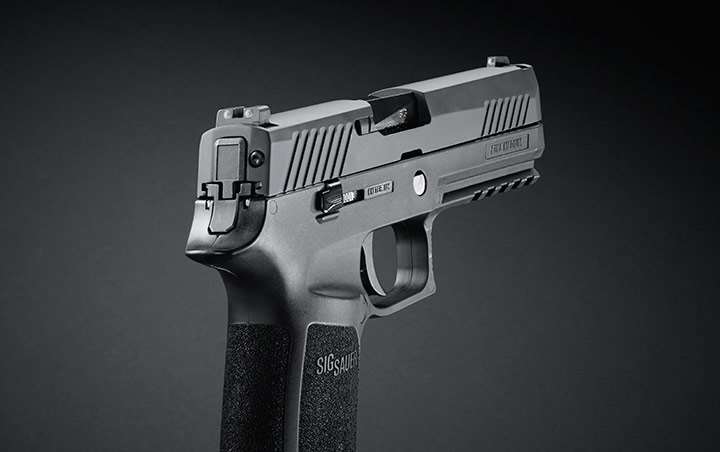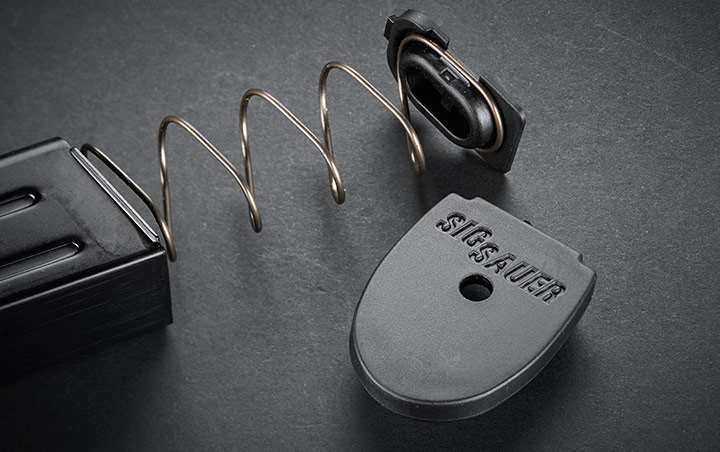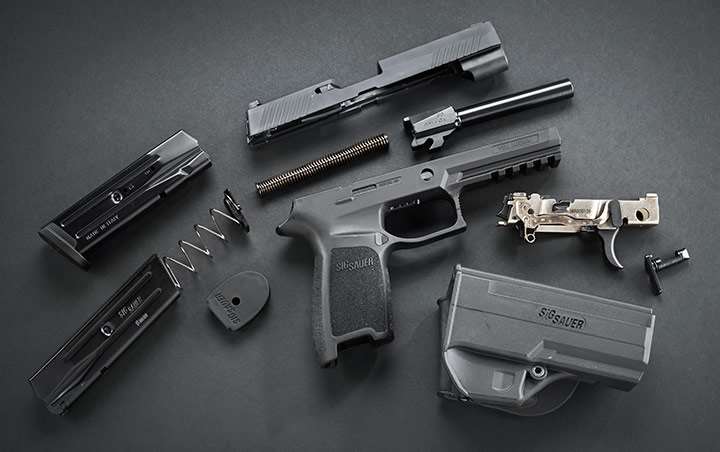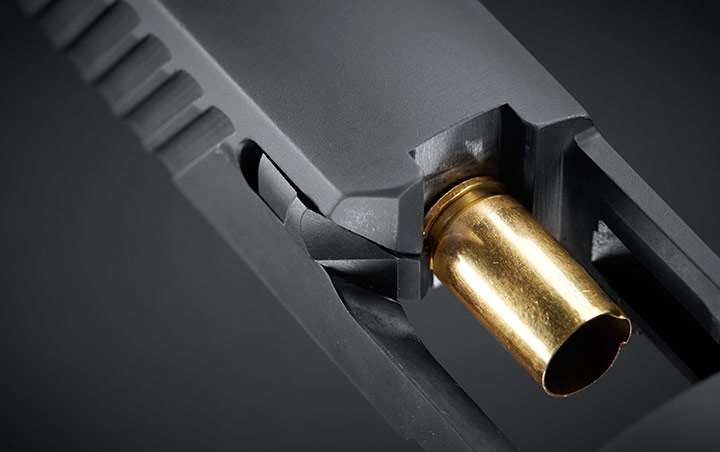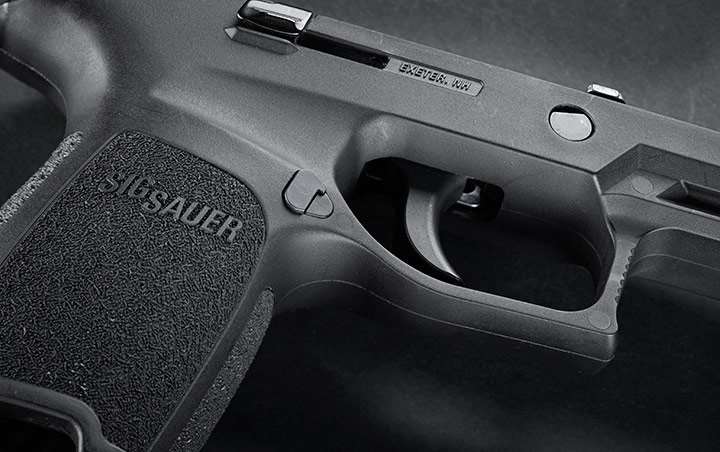
When a pistol-sized box appears on your desk from Newington, N.H., who says "Uh-oh, it's a SIG?"
After all, from the legendary P210, P220 and P226 to the innovative P227 (AW13), SIG Sauer pistols are acknowledged icons of quality, reliability, innovation and accuracy the world over, and have been for decades.
Those nervous guys would be us. Not that we've ever had a problem, mind you, but rather that Cupid's arrow-or bullet?-never quite found the mark with us.
Well, everything changes.
Outside
The cause of our apprehension is the latest addition to the SIG family of pistols: the 320. While the heritage is clearly “P” family, the newest scion of the house claims several innovative developments.
Perhaps most obvious is the lack of an external hammer. Unlike the cosmetically similar P250, the hammer travel “slot” in the rear of both slide and frame is sealed, and with good reason: The 320 is SIG’s entry into the striker-ignition fray.
Like most striker pistols, the 320 is steel above, polymer below. The slide is nitron-finished stainless steel with dovetailed front and rear sights. Our sample pistol was fitted with a pair of SIGLITE night sights. Other slide cuts comprise a nose taper to ease holstering (and to save weight), a generous ejection port, locking notch, disassembly relief, and front and rear cocking serrations.
About those cocking serrations: They might be the best we’ve seen on any pistol, ever. It doesn’t matter how you like to manipulate the slide (from the front or rear of the ejection port, slingshot, web-of-the-hand or cross-gripping), we think their design is ideal. They are deep, but not so deep that they’ll prove a rust or snag hazard—been there, done that. They’re broad, but not so broad as to be ineffectively slippery to the small-fingered, heavily calloused or when wet—been there, done that, too. This may seem like an odd thing to like so much, but when it comes to safety and malfunction clearing, this can be a huge deal.
Dropping down to the frame brings us to another major departure from most of the Ps—said frame, isn’t. Instead of being the serial-numbered heart of the firearm, SIG’s “grip module” is merely one of nine swappable components. With a single acquisition, the 320 gives the owner small, medium and large grip diameters, as well as duty, carry and sub-compact overall pistol size, all with magazines to match.
If that’s a shock, take some time: It settles in nicely the more you think about it.
Molded-in grip texture is common to each grip module. Highly reminiscent of the E2 treatment introduced on the P226, it’s a surface we’ve admired before. We tested it wet, muddied and even oil-slicked. The last is always a challenge, but the 320 soldiered on. We also tried to snag it on various lining/clothing materials, and found it essentially snag-free. One of our test materials was a microfiber-type on which even chapped skin binds badly, but it slid over the SIG texture with ease.
The bottom of the grip module has a feature we expect to see proxied or out-and-out copied, and soon—a generous relief cut which allows a really authoritative grasp of the magazine base plate between thumb and forefinger. As experienced handgun shooters know, a Type 3 malfunction can lock a magazine amazingly, dangerously tight during the dreaded “double-feed,” and serious leverage can be needed to free it. While we did not experience any actual double-feeds during our range tests, we simulated several. The 320 excelled in reducing these stoppages precisely because it provides for such sure magazine removal.
In the past, we’ve seen, and had trouble ourselves, with the position/ architecture of “P” series slide locks, as certain hand dimensions and grips will repeatedly activate the unprotected lever and lock the slide in recoil. We tried to excite this considerable, even dangerous, inconvenience on the P320 and had no success at all. Even with buckier defensive loads, the slide lock never engaged in this—ah, unhelpful?—way. We can’t say whether this is due to the reshaping of the lever to include a downward bevel or the addition of a small “guard” shelf. Either way, it’s a welcome advance.
The magazine release is another clever joy of the P320. Defaulted to the left—sorry southpaws—it’s nevertheless dead simple to swap. The first time we did it, we went slowly to make sure no small parts escaped (particularly the small spring). But the second time we timed it at under a minute, easily.
It’s also our opinion that mag release springs generally have more tension than desirable, but we’d rate this one nearly perfect. The button itself is also a nifty compromise. It’s long enough for easy access, and its triangular shape is nicely beveled and textured for sure tactile feedback without digging into your weak-side palm. For duty or competition, it’s another part that doesn’t demand swap or modification.
For servicing and cleaning, the 320 reprises what we’ve long argued is the best takedown in the world, similar to the Walther P38 of World War II fame. With the slide locked back, a forward, left-side lever rotates to a stop, and, with release of the slide lock, permits the slide to be swept forward off the frame.
In the new SIG, takedown is not only easy—dare we say foolproof—but also exceptionally safe. First, locking the slide back ejects any chambered round and exposes any magazine that might still be in position. Second, the disassembly lever can’t be activated to the release position with a magazine in the grip module, so the ammunition source must be removed. Thirdly, there is no necessity to press the trigger to release the slide: Even if a round manages to remain chambered (mechanically possible, but difficult enough to alert you that something is decidedly amiss), the trigger is still deactivated by the disassembly lever. We’re not saying the system can’t be beat, but we didn’t discover how!
The bilateral “thumb” rests top the clever grip architecture nuances. In a one-handed grip, the thumb certainly finds these commodious. But a modern, two-handed grip has the thumbs otherwise occupied, and these take on a different function. On the left, they prevent the fleshy part of the thumb/hand from unhelpfully contacting the mag release. On the right, we found them a valuable aid to proper grip—the ridge on the underside of the index finger knuckle is an instant cue that hand position is too low, especially when drawing. Lastly, they constitute a de facto relief cut, alternately making the mag release (on the left) and trigger (on the right) easier to reach without compromising overall gripping diameter.
Inside
The 320 is the first striker-fired SIG. Borrowing from the modular P250 (introduced in 2007), it replaces the DA-only, hammer-based action with a striker-based ignition system. As we said, this stainless assembly is the actual pistol, and virtually everything else can be swapped in and out.
These swaps even include caliber: With the P320, 9 mm, .357 SIG, .40 S&W and (eventually) .45 ACP slide assemblies are available to build up from your original core. If that’s not versatile enough for a single serial number, we’re open to suggestions.
With the slide off the pistol, our 9 mm presented other reminders of SIG precision and attention to detail. The barrel is a conventionally rifled design with integral feed ramp—a combination we were able to get to feed spent brass about half the time. Is there any wonder our malfunction report is short?
Unlike some previous “P” family pistols, the 320 uses a long life, flat wire recoil spring with an unusually high turn count (49) on a two-piece steel guide rod.
At The Range
One of the things we immediately liked about the P320 was the inclusion of a holster and second magazine. An irritating hazard of, and barrier to, our sort of analysis can be the availability of this type of kit as there isn’t any good way to proxy the speed of a reload without a second magazine. And generic holsters? The best of them, well, stink.
We didn’t head to the range expecting functional issues— whatever our other apprehensions might have been about the 320, reliability was not among them. Still, we tested a wide range of projectile weights from 90 to162 grains, including bullets of round nose, truncated cone and several different hollow point designs. Overall cartridge lengths varied from 1.020 to 1.160. All were digested effortlessly.
The guide rod/recoil spring configuration handled all bullet types and load levels with ease. Lighter loads cycled decisively with cases ejecting at about the 2:30 position (slightly forward of directly right), while heavier loads tossed cases at a typical 4 to 4:30 position. We never felt the pistol was close to slamming (full spring compression), even with heavy defensive ammunition. Combined with the recoil-dissipating flex of the polymer grip module, the spring/guide rod kept the 320 docile—even with the pistol’s slightly higher bore line—and meant that return to point-of-aim was very predictable.
We even fed the SIG some slightly but deliberately deformed cases to simulate ammunition damage that can occur in the field, but no joy: Feeding and ejection proceeded unabated.
Accuracy was splendid as well, another hallmark of past SIG pistols. With concentration and good trigger work, even a single survivor on the plate rack was rare to 35 yards, and unlikely even at 50.
This we largely credit to the new trigger system. We’ve long noticed that SIG “P” series fans are most frequently those who’ve had extended opportunities to use their SIGs to the exclusion of all others, and, almost as frequently, had access to plenty of training ammunition. Otherwise, mastery of the DA triggers has been variable, or at least lengthy.
These considerations are essentially immaterial on the 320. The short take-up, moderate press weight (nominal of 5.5 pounds, ours settled to about 4.9) and very short reset makes this a system to which most anyone can accommodate well and very quickly. The loooooooong first press that’s so difficult to master is loooooooong gone.
Note that both tabbed and un-tabbed versions (ours) of the trigger are available to meet departmental, agency or personal requirements/preferences. We hadn’t the slightest inkling that this trigger-mounted lever was necessary, and would skip it given the choice. But depending on how you count, this adds a fourth safety to the out-of-battery/disconnector, and drop/striker safeties present in every pistol, irrespective of trigger choice.
Gripes
Our range work is probably predictive of what we have in terms of gripes—darned few. In fact, the only one is a matter merely of taste, and is easily amended.
In darkness or low light, we like the SIGLITE sights. They are added to the pistol as an option and at a very reasonable price too. The potential for difficulty, however, appears in daylight use. Over time, general grime and carbon tend to attach themselves to the lenses of the tritium lamps, and turn what are decently whitish dots an unhelpful gray. Before long, the “three-dot” tactical style sight picture fades, and cleaning cannot fully restore it.
To many shooters, this doesn’t matter much: They’re aiming based on the notch-and-post for distance precision, and the dots remain satisfactory closer in. If this is you, then you’re good. If not, consider something like the Trijicon HD (NRA/AW review here), TruGlo TFO (review here) or the soon-to-be-released XS 24/7 sights (review here). If your SIG is destined for competition, consider the Battlehook: Their exceptionally low profile is a great complement to the P320. Come to think of it, their duty sights are great too (due in December 2014).
The second item isn’t a gripe either, but a caution. SIG notes— with justification—that there is no necessity to press the trigger for disassembly, and they are correct. That’s a nice safety touch as we observed in our discussion of takedown, but also not unique: We know of at least one other properly cleared striker-fired pistol that shares this characteristic. The potential for an unintended consequence occurs upon reassembly, however. A nimble, practiced hand may be tempted to reassemble a freshly maintained 320 without employing the slide lock, and doing so appears to work.
It also results in a dead trigger. Reinstating proper trigger function is easy—just pull the slide to the rear and engage the slide lock (you’ll hear a “click”) and re-release the slide. Merely racking the slide, even repeatedly, will not restore trigger function—it’s the slide lock lever that does the trick.
This is not a malfunction or design error, as there’s no way to seat a magazine in the pistol until the proper procedure has been completed. SIG’s
outstanding manual details correct reassembly (page 38, steps 6-8), but we couldn’t find a reference to this apparent “gotcha.” If you discover this inadvertently, at least you’ll now know there is absolutely nothing wrong with your P320.
Final Analysis
We alluded in our title that the P320 was a departure for SIG, and we stick by that assessment. The striker-based ignition and switchable polymer grip systems are obvious to all, and for many applications represent that—ahem—SIGnificant leap.
But the devil, as they say, is in the details, and in this case we think SIG got even more important things right. A single, consistent, short-reset trigger press is the standout to us, but the dazzling versatility isn’t far behind (6,900+ possible combinations our math—we think—reveals). And all of this comes without a remotely consequential nick in SIG’s traditional stock-in-trade—accuracy, reliability and granite- esque durability.
We get to the metaphorical end of the day, therefore, with none of our past SIG Sauer “P” series caveats. In our view, the P320 isn’t merely good, or even very good.
It’s great.

